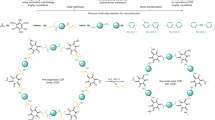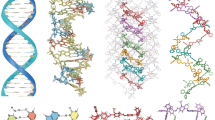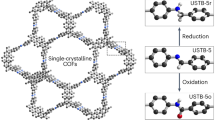Abstract
Covalent organic frameworks (COFs) formed by connecting multidentate organic building blocks through covalent bonds provide a platform for designing multifunctional porous materials with atomic precision. As they are promising materials for applications in optoelectronics, they would benefit from a maximum degree of long-range order within the framework, which has remained a major challenge. We have developed a synthetic concept to allow consecutive COF sheets to lock in position during crystal growth, and thus minimize the occurrence of stacking faults and dislocations. Hereby, the three-dimensional conformation of propeller-shaped molecular building units was used to generate well-defined periodic docking sites, which guided the attachment of successive building blocks that, in turn, promoted long-range order during COF formation. This approach enables us to achieve a very high crystallinity for a series of COFs that comprise tri- and tetradentate central building blocks. We expect this strategy to be transferable to a broad range of customized COFs.
This is a preview of subscription content, access via your institution
Access options
Subscribe to this journal
Receive 12 print issues and online access
$259.00 per year
only $21.58 per issue
Buy this article
- Purchase on Springer Link
- Instant access to full article PDF
Prices may be subject to local taxes which are calculated during checkout





Similar content being viewed by others
References
Doonan, C. J., Tranchemontagne, D. J., Glover, T. G., Hunt, J. R. & Yaghi, O. M. Exceptional ammonia uptake by a covalent organic framework. Nature Chem. 2, 235–238 (2010).
Rabbani, M. G. et al. A 2D mesoporous imine-linked covalent organic framework for high pressure gas storage applications. Chem. Eur. J. 19, 3324–3328 (2013).
Ding, S.-Y. et al. Construction of covalent organic framework for catalysis: Pd/COF-LZU1 in Suzuki–Miyaura coupling reaction. J. Am. Chem. Soc. 133, 19816–19822 (2011).
Dogru, M. et al. A photoconductive thienothiophene-based covalent organic framework showing charge transfer towards included fullerene. Angew. Chem. Int. Ed. 52, 2920–2924 (2013).
Calik, M. et al. Extraction of photogenerated electrons and holes from a covalent organic framework integrated heterojunction. J. Am. Chem. Soc. 136, 17802–17807 (2014).
Patwardhan, S., Kocherzhenko, A. A., Grozema, F. C. & Siebbeles, L. D. A. Delocalization and mobility of charge carriers in covalent organic frameworks. J. Phys. Chem. C 115, 11768–11772 (2011).
Jin, S. et al. Charge dynamics in a donor–acceptor covalent organic framework with periodically ordered bicontinuous heterojunctions. Angew. Chem. Int. Ed. 52, 2017–2021 (2013).
Bertrand, G. H. V., Michaelis, V. K., Ong, T.-C., Griffin, R. G. & Dinca, M. Thiophene-based covalent organic frameworks. Proc. Natl Acad. Sci. USA 110, 4923–4928 (2013).
Côte, A. P. et al. Porous, crystalline, covalent organic frameworks. Science 310, 1166–1170 (2005).
Spitler, E. L. & Dichtel, W. R. Lewis acid-catalysed formation of two-dimensional phthalocyanine covalent organic frameworks. Nature Chem. 2, 672–677 (2010).
Dogru, M., Sonnauer, A., Gavryushin, A., Knochel, P. & Bein, T. A covalent organic framework with 4 nm open pores. Chem. Commun. 47, 1707–1709 (2011).
Spitler, E. L. et al. Lattice expansion of highly oriented 2D phthalocyanine covalent organic framework films. Angew. Chem. Int. Ed. 51, 2623–2627 (2012).
Medina, D. D. et al. Oriented thin films of a benzodithiophene covalent organic framework. ACS Nano 8, 4042–4052 (2014).
Medina, D. D. et al. Room temperature synthesis of covalent−organic framework films through vapor-assisted conversion. J. Am. Chem. Soc. 137, 1016–1019 (2015).
Uribe-Romo, F. J. et al. A crystalline imine-linked 3-D porous covalent organic framework. J. Am. Chem. Soc. 131, 4570–4571 (2009).
Wan, S. et al. Covalent organic frameworks with high charge carrier mobility. Chem. Mater. 23, 4094–4097 (2011).
Guo, J. et al. Conjugated organic framework with three-dimensionally ordered stable structure and delocalized π clouds. Nature Commun. 4, 2736 (2013).
Fang, Q. et al. Designed synthesis of large-pore crystalline polyimide covalent organic frameworks. Nature Commun. 5, 4503 (2014).
Jackson, K. T., Reich, T. E. & El-Kaderi, H. M. Targeted synthesis of a porous borazine-linked covalent organic framework. Chem. Commun. 48, 8823–8825 (2012).
Kuhn, P., Antonietti, M. & Thomas, A. Porous, covalent triazine-based frameworks prepared by ionothermal synthesis. Angew. Chem. Int. Ed. 47, 3450–3453 (2008).
Zhang, Y.-B. et al. Single-crystal structure of a covalent organic framework. J. Am. Chem. Soc. 135, 16336–16339 (2013).
Jones, J. T. A. et al. Modular and predictable assembly of porous organic molecular crystals. Nature 474, 367–371 (2011).
Kandambeth, S. et al. Enhancement of chemical stability and crystallinity in porphyrin-containing covalent organic frameworks by intramolecular hydrogen bonds. Angew. Chem. Int. Ed. 52, 13052–13056 (2013).
Shinde, D. B., Kandambeth, S., Pachfule, P., Kumar, R. R. & Banerjee, R. Bifunctional covalent organic frameworks with two dimensional organocatalytic micropores. Chem. Commun. 51, 310–313 (2014).
Spitler, E. L. et al. A 2D covalent organic framework with 4.7-nm pores and insight into its interlayer stacking. J. Am. Chem. Soc. 133, 19416–19421 (2011).
Dogru, M. & Bein, T. On the road towards electroactive covalent organic frameworks. Chem. Commun. 50, 5531–5546 (2014).
Zhou, T.-Y., Xu, S.-Q., Wen, Q., Pang, Z.-F. & Zhao, X. One-step construction of two different kinds of pores in a 2D covalent organic framework. J. Am. Chem. Soc. 136, 15885–15888 (2014).
Hasell, T., Schmidtmann, M., Stone, C. A., Smith, M. W. & Cooper, A. I. Reversible water uptake by a stable imine-based porous organic cage. Chem. Commun. 48, 4689–4691 (2012).
Clark, S. J. et al. First principles methods using CASTEP. Z. Kristallogr. 220, 567–570 (2005).
Perdew, J. P., Burke, K. & Ernzerhof, M. Generalized gradient approximation made simple. Phys. Rev. Lett. 77, 3865–3868 (1996).
Monkhorst, H. J. & Pack, J. D. Special points for Brillouin-zone integrations. Phys. Rev. B 13, 5188–5192 (1976).
McNellis, E. R., Meyer, J. & Reuter, K. Azobenzene at coinage metal surfaces: role of dispersive van der Waals interactions. Phys. Rev. B 80, 205414 (2009).
Tkatchenko, A. & Scheffler, M. Accurate molecular van der Waals interactions from ground-state electron density and free-atom reference data. Phys. Rev. Lett. 102, 073005 (2009).
Sing, K. S. W. et al. Reporting physisorption data for gas/solid systems with special reference to the determination of surface area and porosity. Pure Appl. Chem. 57, 603–619 (1985).
Thommes, M. Physical adsorption characterization of nanoporous materials. Chem. Ing. Tech. 82, 1059–1073 (2010).
Acknowledgements
We are grateful for funding from the German Science Foundation (Research Cluster Nanosystems Initiative Munich) and the Free State of Bavaria (Research Network SolTech). The research leading to these results received funding from the European Research Council under the European Union's Seventh Framework Programme (FP7/2007-2013)/ERC Grant Agreement 321339. This research used beamlines 11-BM and 11-ID-B at the Advanced Photon Source, a US Department of Energy (DOE) Office of Science User Facility operated for the DOE Office of Science by Argonne National Laboratory under Contract No. DE-AC02-06CH11357.
Author information
Authors and Affiliations
Contributions
L.A., T.S. and F.A. conceived and designed the project. L.A., T.S., M.C. and F.A. carried out the syntheses and characterized the materials. C.H. performed the single-crystal analysis. S.H.L. and K.W.C. performed the synchrotron X-ray scattering measurements and analysed the data. J.T.M. and T.C. carried out the theoretical simulations. M.D. carried out the TEM characterization. L.A. and F.A. wrote the manuscript. F.A. and T.B. supervised the project. All the authors discussed the results and contributed to the manuscript.
Corresponding authors
Ethics declarations
Competing interests
The authors declare no competing financial interests.
Supplementary information
Supplementary information
Supplementary information (PDF 3033 kb)
Supplementary information
Crystallographic data for compound 2 (CIF 801 kb)
Supplementary information
Structure factors file for compound 2 (FCF 453 kb)
Supplementary information
Crystallographic data obtained by Rietveld refinement for the 4PE-1P COF (CIF 2 kb)
Supplementary information
Crystallographic data obtained by Rietveld refinement for the 4PE-2P COF (CIF 2 kb)
Supplementary information
Crystallographic data obtained by Rietveld refinement for the 4PE-3P COF (CIF 3 kb)
Supplementary information
Crystallographic data obtained by Rietveld refinement for the 4PE-TT COF (CIF 2 kb)
Rights and permissions
About this article
Cite this article
Ascherl, L., Sick, T., Margraf, J. et al. Molecular docking sites designed for the generation of highly crystalline covalent organic frameworks. Nature Chem 8, 310–316 (2016). https://doi.org/10.1038/nchem.2444
Received:
Accepted:
Published:
Issue Date:
DOI: https://doi.org/10.1038/nchem.2444
This article is cited by
-
Ultralight crystalline hybrid composite material for highly efficient sequestration of radioiodine
Nature Communications (2024)
-
Linkage conversions in single-crystalline covalent organic frameworks
Nature Chemistry (2024)
-
Symmetry-breaking dynamics in a tautomeric 3D covalent organic framework
Nature Communications (2023)
-
Covalent organic frameworks
Nature Reviews Methods Primers (2023)
-
Synthesis of a covalent organic framework with hetero-environmental pores and its medicine co-delivery application
Nature Communications (2023)



